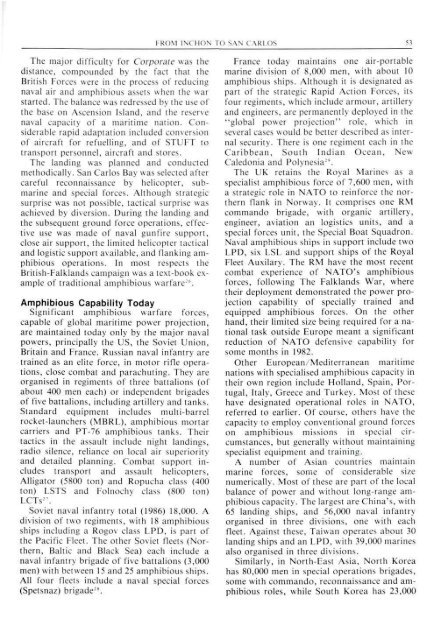ISSUE 76 : May/Jun - 1989 - Australian Defence Force Journal
ISSUE 76 : May/Jun - 1989 - Australian Defence Force Journal
ISSUE 76 : May/Jun - 1989 - Australian Defence Force Journal
- No tags were found...
Create successful ePaper yourself
Turn your PDF publications into a flip-book with our unique Google optimized e-Paper software.
I ROM INCHON TO SAN CARLOS 53The major difficulty for Corporate was thedistance, compounded by the fact that theBritish <strong>Force</strong>s were in the process of reducingnaval air and amphibious assets when the warstarted. The balance was redressed by the use ofthe base on Ascension Island, and the reservenaval capacity of a maritime nation. Considerablerapid adaptation included conversionof aircraft for refuelling, and of STUFT totransport personnel, aircraft and stores.The landing was planned and conductedmethodically. San Carlos Bay was selected aftercareful reconnaissance by helicopter, submarineand special forces. Although strategicsurprise was not possible, tactical surprise wasachieved by diversion. During the landing andthe subsequent ground force operations, effectiveuse was made of naval gunfire support,close air support, the limited helicopter tacticaland logistic support available, and flanking amphibiousoperations. In most respects theBritish-Falklands campaign was a text-book exampleof traditional amphibious warfare 2 '.Amphibious Capability TodaySignificant amphibious warfare forces,capable of global maritime power projection,are maintained today only by the major navalpowers, principally the US, the Soviet Union,Britain and France. Russian naval infantry aretrained as an elite force, in motor rifle operations,close combat and parachuting. They areorganised in regiments of three battalions (ofabout 400 men each) or independent brigadesof five battalions, including artillery and tanks.Standard equipment includes multi-barrelrocket-launchers (MBRL), amphibious mortarcarriers and PT-<strong>76</strong> amphibious tanks. Theirtactics in the assault include night landings,radio silence, reliance on local air superiorityand detailed planning. Combat support includestransport and assault helicopters,Alligator (5800 ton) and Ropucha class (400ton) LSTS and Folnochy class (800 ton)LCTs 27 .Soviet naval infantry total (1986) 18,000. Adivision of two regiments, with 18 amphibiousships including a Rogov class LPD, is part ofthe Pacific Fleet. The other Soviet fleets (Northern,Baltic and Black Sea) each include anaval infantry brigade of five battalions (3,000men) with between 15 and 25 amphibious ships.All four fleets include a naval special forces(Spetsnaz) brigade 28 .France today maintains one air-portablemarine division of 8,000 men, with about 10amphibious ships. Although it is designated aspart of the strategic Rapid Action <strong>Force</strong>s, itsfour regiments, which include armour, artilleryand engineers, are permanently deployed in the"global power projection" role, which inseveral cases would be better described as internalsecurity. There is one regiment each in theCaribbean, South Indian Ocean, NewCaledonia and Polynesia 2 '.The UK retains the Royal Marines as aspecialist amphibious force of 7,600 men, witha strategic role in NATO to reinforce the northernflank in Norway. It comprises one RMcommando brigade, with organic artillery,engineer, aviation an logistics units, and aspecial forces unit, the Special Boat Squadron.Naval amphibious ships in support include twoLPD, six LSL and support ships of the RoyalFleet Auxilary. The RM have the most recentcombat experience of NATO's amphibiousforces, following The Falklands War, wheretheir deployment demonstrated the power projectioncapability of specially trained andequipped amphibious forces. On the otherhand, their limited size being required for a nationaltask outside Europe meant a significantreduction of NATO defensive capability forsome months in 1982.Other European/Mediterranean maritimenations with specialised amphibious capacity intheir own region include Holland, Spain, Portugal,Italy, Greece and Turkey. Most of thesehave designated operational roles in NATO,referred to earlier. Of course, others have thecapacity to employ conventional ground forceson amphibious missions in special circumstances,but generally without maintainingspecialist equipment and training.A number of Asian countries maintainmarine forces, some of considerable sizenumerically. Most of these are part of the localbalance of power and without long-range amphibiouscapacity. The largest are China's, with65 landing ships, and 56,000 naval infantryorganised in three divisions, one with eachfleet. Against these, Taiwan operates about 30landing ships and an LPD, with 39,000 marinesalso organised in three divisions.Similarly, in North-East Asia, North Koreahas 80,000 men in special operations brigades,some with commando, reconnaissance and amphibiousroles, while South Korea has 23,000
















